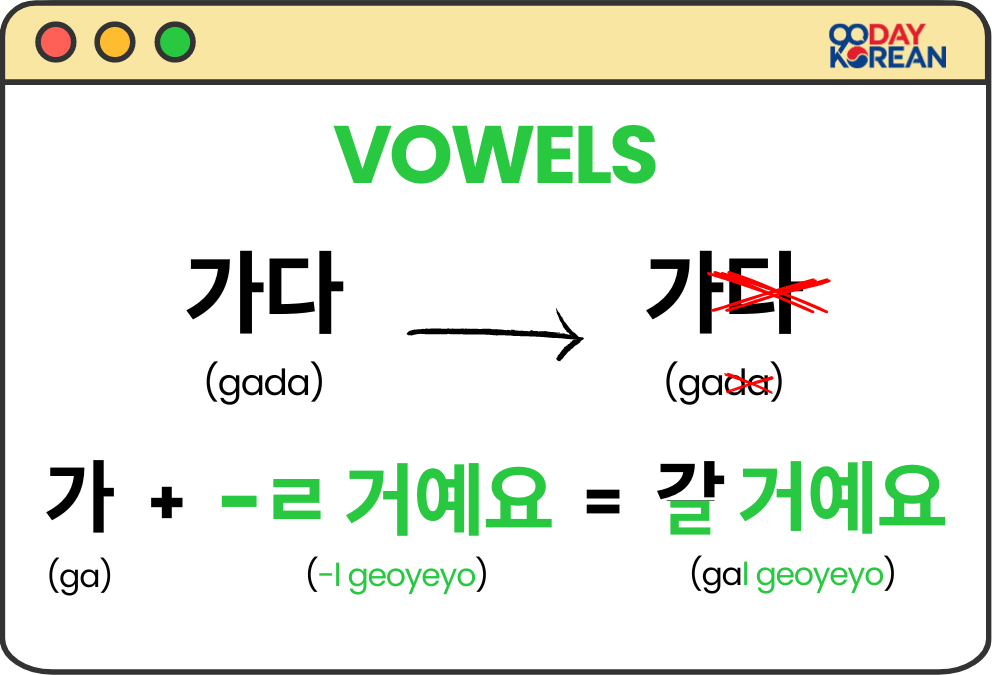To specific one thing within the Korean future tense, use the endings -ㄹ/을 거예요 (-l/eul geoyeyo), -ㄹ/을게요 (-l/eulgeyo), and -겠어요 (-gesseoyo). Identical to in different languages, these endings describe what’s going to occur sooner or later.

The long run tense in Korean can point out each “will” and “going to.” This information will enable you to kind and use the longer term tense to obviously specific your intentions. In comparison with different tenses, the longer term tense is sort of easy. Let’s discover why!
Fast Abstract
Transient Overview of Korean Verb Tenses
As talked about in our different articles, there are three essential tenses in Korean: current, previous, and future. The long run tense could be the best to be taught. It’s used to specific one thing that can occur however hasn’t occurred but.
You should use it for occasions occurring in a number of hours, subsequent yr, or any time in between. Beneath, we’ll train you the way to use the longer term tense successfully in day by day conversations.
Future Tense Endings
There are three endings used to specific the longer term tense in Korean. The commonest one is:
- -ㄹ/을 거예요 (-l/eul geoyeyo)
The opposite two endings are:
- -ㄹ/을게요 (-l/eulgeyo)
- -겠어요 (-gesseoyo)
The Korean future tense can imply each “will” and “going to,” so you need to use the identical endings to specific both intention.
How do you kind the longer term tense in Korean?
To kind the longer term tense in Korean, it’s worthwhile to add the proper future tense endings to the verb stem. The ending you employ is dependent upon how the stem ends and the state of affairs. Generally, the verb stem must be modified earlier than including the longer term tense endings.
Korean Future Tense Ending -ㄹ/을 거예요 (-l/eul geoyeyo)
Like with different conjugations, take away the -다 from the verb stem to begin.
If the verb stem ends with a vowel, add -ㄹ 거예요 (-l geoyeyo). For instance, with 가다 (gada), take away 다 (da) to get 가 (ga). Then add -ㄹ 거예요 (-l geoyeyo) to make 갈 거예요 (gal geoyeyo).


내일 학교에 갈 거예요. (naeil hakgyoe gal geoyeyo)
I’ll go to the college tomorrow.
However, if the verb stem ends with a consonant, add -을 거예요 (-eul geoyeyo). For instance, with 닫다 (datda), take away 다 (da) to get 닫 (dat). Then add -을 거예요 (-eul geoyeyo) to make 닫을 거예요 (dadeul geoyeyo).


Instance:
비가 오면 문을 닫을 거예요. (biga omyeon muneul dadeul geoyeyo)
I’ll shut the door if it rains.
When a Korean verb stem ends with the consonant ㄹ, simply add -거예요 (-geoyeyo) to kind the longer term tense. That is less complicated since you don’t want so as to add the ㄹ sound or change the stem. For instance, 살다 (salda) turns into 살 거예요 (sal geoyeyo) as an alternative of 살을 거예요 (sareul geoyeyo).
Instance:
우리는 이제부터 이 집에서 살 거예요. (urineun ijebuteo i jibeseo sal geoyeyo)
We are going to reside on this home any further.
That is the way you make future tense typically. Different verbs require altering the stem, that are irregular verbs. We’ll go over them in additional element under.
Korean Future Tense Guidelines
Identical to different tenses, the longer term tense follows particular guidelines. Nevertheless, conjugating the longer term tense in Korean is usually less complicated than different tenses. Right here’s a information that can assist you conjugate among the frequent sorts of irregular verbs:
1. ㄷ Irregular
The ㄷ within the verb stem modifications to ㄹ. For instance, the stem 듣- (deut-) modifications to 들- (deul-). Then, add -을 거예요 (-eul geoyeyo) to kind the longer term tense. So, the longer term type of 듣다 (deutda) turns into 들을 거예요 (deureul geoyeyo), which means “I’ll hear/hear.”
Instance:
이 노래를 매일 들을 거예요. (i noraereul maeil deureul geoyeyo)
I’ll hear to this track day-after-day.
2. ㅂ Irregular
Take away the ㅂ and substitute it with 우, then add -ㄹ 거예요 (-r geoyeyo). For instance, 춥다 (chupda | to be chilly) has the stem 춥 (chup), which modifications to 추우 (chuu). The long run type of 춥다 (chupda) is 추울 거예요 (chuul geoyeyo), which means “It will likely be chilly.”
Instance:
내일은 날씨가 아주 추울 거예요. (naeireun nalssiga aju chuul geoyeyo)
The climate will probably be very chilly tomorrow.
3. ㅅ Irregular
Drop the ㅅ from the stem and add -을 거예요 (-eul geoyeyo). For instance, with 낫다 (natda | to get better), take away the ㅅ from 낫 (nat) to get 나 (na). Then add -을 거예요 (-eul geoyeyo) to kind the longer term tense. The long run kind is 나을 거예요 (naeul geoyeyo), which means “I’ll get better.”
Instance:
약을 먹었으니까 금방 나을 거예요. (yageul meogeosseunikka geumbang naeul geoyeyo)
I’ve taken the drugs, so I’ll get higher quickly.
4. Conjugating 이다
While you conjugate the verb “to be” (이다 | ida) into the longer term tense, it turns into 일 거예요 (il geoyeyo), implying a guess or risk, much like “could be” in English.
To specific that somebody will change into one thing, like a flight attendant, use the verb 되다 (doeda), which means “to change into.” Sooner or later tense, 되다 (doeda) turns into 될 거예요 (doel geoyeyo) by including -ㄹ 거예요 (-l geoyeyo) to the stem 되 (doe).
Examples:
그 사람은 한국 사람일 거예요. (geu sarameun hanguk saramil geoyeyo)
That particular person could be Korean.
그 사람은 승무원이 될 거예요. (geu sarameun seungmuwoni doel geoyeyo)
That particular person will change into a flight attendant.
5. Conjugating 있다
We all know that 있다 (itda) can be utilized to specific location and possession.
Expressing Location – When expressing location sooner or later tense, 있다 (itda) turns into 있을 거예요 (isseul geoyeyo).
Expressing Possession – Utilizing 있다 (itda) sooner or later tense to specific possession isn’t unsuitable however sounds unnatural. As a substitute, use verbs like “purchase” or “get” to specific future possession. For instance, as an alternative of claiming you should have one thing, say you’ll purchase or get it.
Instance:
저는 주말에 집에 있을 거예요. (jeoneun jumare jibe isseul geoyeyo)
I will probably be at dwelling on the weekend.
Korean Future Tense Ending -ㄹ/을게요
The ending -ㄹ/을게요 (-l/eulgeyo) is used for making guarantees, like saying “I’ll do one thing” in English. It’s informal and solely used with the first-person topic.
If the verb stem ends in a vowel, add -ㄹ게요 (-lgeyo). If the verb stem ends in a consonant, add -을게요 (-eulgeyo).
Examples:
제가 커피를 살게요. (jega keopireul salgeyo)
I will purchase espresso.
나중에 전화할게요. (najunge jeonhwahalgeyo)
I’ll name later.
Korean Future Tense Ending -겠어요
-겠어요 (-gesseoyo) is one other future tense verb ending. It reveals a stronger intention than the first future tense ending. This type is seen as extra emphatic. Each verb stem is conjugated the identical manner with this ending, whatever the closing letter.
Instance:
올해는 담배를 끊겠어요. (olhaeneun dambaereul kkeunkesseoyo)
I’m going to stop smoking this yr.
What to do subsequent after studying the Korean Future Tense
To additional your understanding of Korean and improve your language expertise, think about exploring these further matters:
- Korean Verbs – Deepen your understanding of Korean verbs, their sorts, and makes use of.
- Korean Conjugation – Study the foundations and patterns for conjugating verbs throughout totally different tenses and formalities.
- Korean Particles – Grasp using Korean particles to construction sentences precisely.
Ceaselessly Requested Questions (FAQs)
Beneath, we’ve listed down probably the most generally requested questions on Korean Future Tense.
1. What are the alternative ways to specific the longer term tense in Korean?
There are three alternative ways to specific the longer term tense in Korean. They’re -ㄹ/을 거예요 (-l/eul geoyeyo), -ㄹ/을게요 -ㄹ/을게요 (-l/eulgeyo) and -겠어요 (-gesseoyo).
2. How do you select between -ㄹ 거예요, -ㄹ게요, and -겠어요?
-ㄹ 거예요 (-l geoyeyo) is used for merely stating future details. -ㄹ게요 (-rgeyo) is extra private and casual, typically used when making guarantees or choices in dialog. -겠어요 (-gesseoyo) is used to specific the speaker’s will or intention.
3 . What’s the future tense of 이다 (to be) in Korean?
The long run tense of the Korean verb 이다 (ida), which means “to be,” is 일 거예요 (il geoyeyo). Nevertheless, this typically means “could be” in English. You should use 될 거예요 (doel geoyeyo) to specific “will probably be/change into,” which is from the verb 되다 (doeda | to change into).
Conclusion
Now you understand how to kind the Korean future tense utilizing three endings: -ㄹ/을 거예요 (-l/eul geoyeyo), -ㄹ/을게요 (-l/eulgeyo), and -겠어요 (-gesseoyo).
These endings enable you to inform future actions, make guarantees, or specific your will to do one thing. Bear in mind particular guidelines, like altering ㄷ to ㄹ for simpler pronunciation.
Wasn’t that surprisingly simple to be taught? Attempt utilizing these endings to say what you’ll do tomorrow and share it within the feedback under!
Was this publish useful?
SureNo

